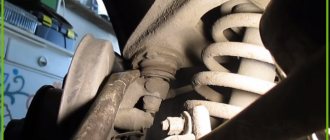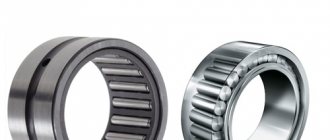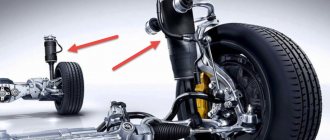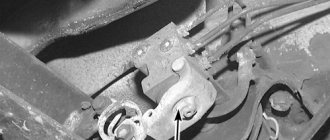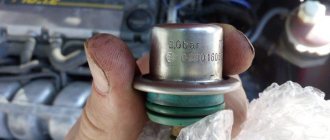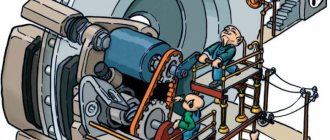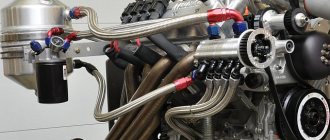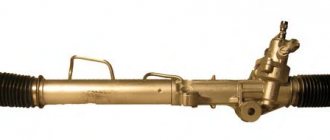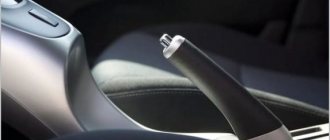Any car suspension contains elastic elements, damping and guides. Manufacturers strive to bring the properties of each unit as close as possible to the theoretical ideal. This is where the organic shortcomings of frequently used solutions surface, such as leaf springs, springs and oil-filled hydraulic shock absorbers. As a result, some companies decide to take a drastic step, using hydropneumatics in the suspension.
Let's make the car jump and dance
To get a Dancer, or dancing car, a special suspension is used. For a dancing car, pneumatic shock absorbers are used. These are elastic rubber pneumatic elements filled with compressed air. As the pressure increases, the volume increases, allowing the ride height to be adjusted. The source of compressed air is a receiver into which air is pumped by a compressor.
Components:
- Pneumatic elements with air supply valves.
- Receiver.
- Compressor.
- Remote control.
When turning, such a car does not roll and does not stick its nose into the surface when braking. The advantages of air suspension are beyond doubt:
- Cheapness.
- Reliability.
- Easy to install and maintain.
- Powered by car battery.
To equip such a suspension, conventional shock absorbers are replaced with pneumatic elements, acquiring the remaining components of the system.
The hydraulic suspension, a lowrider's dream, allows the car to bounce along the road.
Installation of hydraulics requires preparation:
- Electric pumps for pumping liquid.
- Additional batteries.
- Hydraulic cylinders for raising the body.
- Pipeline with valve systems.
- Body bumpers.
- Hydraulic accumulators for smooth running.
- Additional batteries.
- Remote Control.
The hydraulic kit allows the car to compete in low car jumping competitions. Competitions are controlled remotely from consoles.
A car with hydraulic suspension can change ground clearance and sway without losing balance. Calculation of parameters allows you to select the suspension to suit the needs of the car owner.
tweet
back Improve the car's handling and appearance by lowering it
Forward Coilovers or, as they are also called, car helical suspension
Links[edit]
- Heißing, Bernd; Ersoy, Metin: Fahrwerkhandbuch - Grundlagen, Fahrdynamik, Komponenten, Systeme, Mechatronik, Perspektiven. Wiesbaden: Vieweg/Teubner, 2008
- https://www.linguee.com/french-english/translation/suspension+oléopneumatique.html
- ^ abcde Reynolds, John: Dare to be Different p.75. Haynes, 2004
- "Archival copy". Archived from the original on 2015-02-06. Retrieved 29 January 2015.CS1 maint: archived copy as title (link)
- "Hydropneumatic shock absorber US 1967641 A".
- "Shock Absorbing Device US 1918697 A".
- ^ ab "Two-stage oleo-pneumatic shock absorber". google.com
. - ^ ab "Project Report" (PDF). www.wpi.edu
. - ^ ab "Archive copy". Archived from the original on 2015-01-29. Retrieved 29 January 2015.CS1 maint: archived copy as title (link)
- "Data" (PDF). www.hydragas.co.uk
. - "Archival copy". Archived from the original on 2015-01-29. Retrieved 29 January 2015.CS1 maint: archived copy as title (link)
- "1971 Citroen DS". nbc.com
. January 12, 2015. - "Archival copy". Archived from the original on 2015-01-29. Retrieved 29 January 2015.CS1 maint: archived copy as title (link)
- "Lexus LX 470 Suspension System". activesuspensionsystems.com
. - Popular Science. Bonnier Corporation. 1991. p. 29. Retrieved June 12, 2022.
- REINE, Les RENDEZ-VOUS de La. “TRACTION AVANT 15cv, 6 cylinders, hydraulic suspension! LA REINE DE LA ROUTE - LES RENDEZ VOUS DE LA REINE." lesrendezvousdelareine.com
. - "1955 Citroën DS 19 - Citroën - SuperCars.net". supercars.net
. March 31, 2016 - "Citroën Faces - The people behind Citroën". Source: Citroën
. Archived from the original on 2009-08-03. Retrieved April 1, 2014. Majes was the author of the DS hydropneumatic suspension. His ideas were discovered by chance by Pierre Boulanger, and Boulanger was fascinated by them, although Citroën technicians considered them hopeless. Boulanger hired Mages in the development department. A decision he would never regret. Paul Majes was a curious person and studied all the literature concerning wheel suspension, suspension in general and braking systems. - "Hydraulics information" (PDF). www.mycitroen.dk/library
. - “Project Car Hell, Budget Edition Video: Silver Cloud or Silver Shadow?” . autoweek.com
. - Jackson, Tony; Bardenwerper, Mark L. (March 2016). "Revised summary of Citroën hydraulic fluids". citroen.cappyfabrics.com
. - ^ ab "LDS Fluid Data Sheet" (PDF). lubadmin.com
. - "Citroën XM Specifications". Citroenet.org.uk. 2000-06-10. Retrieved June 29, 2022.
Purpose and design of car suspension
Vehicle suspension device
So, what is the purpose of a car suspension? It, like its distant predecessors, installed in horse-drawn carriages, is designed to make movement more comfortable and safe. Elastic suspension elements dampen shocks, shocks and vibrations that accompany any trip on any road.
However, the tasks of the suspension are not limited to comfort alone. Its second function is to help with maneuvers. The complexity of the suspension design is often due to this very reason: engineers are still trying to add stability, controllability, and safety to the car.
And finally, the modern suspension helps a lot in braking, absorbing forward inertia. The quality of braking can sometimes determine how the suspension is configured and how functional it is.
What is included in the suspension device? Simply put, everything that is between the wheels and the power frame of the car. These are well-known shock absorbers (where would we be without them), springs, levers, rods, stabilizers, ball joints, silent blocks and other elements. Conventionally, they can be divided into the following categories:
- All types of springs, leaf springs and torsion bars belong to the elastic elements of the suspension. Their task is to absorb and spring back shocks from driving over uneven surfaces.
- All types of shock absorbers (conventional oil and gas-oil, pneumatic, magnetic) belong to the damping elements of the suspension. They must absorb shocks and vibrations without releasing them further onto the car body.
- Levers, steering knuckles, transverse rods are guide elements. Their task is to form the correct position of the wheel when turning and moving in a straight line. To turn the wheels, a steering mechanism is sufficient, but in order for the wheel to take the correct position during maneuvers, suspension elements are needed.
- Silent blocks, ball joints and other small rubber-metal parts are needed not only to fasten all suspension elements together, but also to partially mitigate vibration and shock.
- The anti-roll bar, as the name implies, is designed to level the body during turns so that the car does not fall to one side during sharp maneuvers.
DIY hydraulic press with electric drive: components and assembly
Hydraulic diagram
Equipment such as an electro-hydraulic press, due to its versatility and high efficiency, is actively used both in large manufacturing enterprises and in small workshops, as well as at car service stations. Using a hydraulic press equipped with an electric drive, you can solve many technical problems, which include:
- pressing, pressing out of gears, bearings and shafts;
- stamping, straightening and bending of metal products;
- pressing of products made from wood shavings, plastic and metal.
Key elements of the Hydractive suspension
A modern Hydractive system consists of the following main elements:
- Hydroelectronic control unit - hydrotronic (1), regulating the pressure and amount of fluid in the system
- Front (2) and rear (5) hydropneumatic elements that act as damping and elastic suspension elements
- Front (3) and rear (6) additional hydropneumatic spheres that regulate suspension stiffness
- Front (4) and rear (7) ride height sensors
- Built-in interface (8)
- Steering wheel position sensor (9)
- Expansion tank with liquid (10)
- Accelerator pedal (11)
- Brake pedal (12)
Basic mechanical diagram[edit]
Blue: nitrogen gas; Gold: Hydraulic fluid under pressure from an engine driven pump.
This system uses a belt or camshaft driven pump from the engine to pressurize a special hydraulic fluid, which then operates the brakes, suspension and power steering. [9] It can also operate any number of functions, such as the clutch, cornering lights, and even power windows. [ citation needed
]
Nitrogen is used as the entrained compression gas as it is unlikely to cause corrosion. A nitrogen reservoir of variable volume produces a spring with nonlinear force and deflection characteristics. [ citation needed
] Thus, the resulting system does not exhibit any of the natural frequencies and associated dynamic instability that must be suppressed through extensive damping in conventional suspension systems.
[ Citation needed
] Actuation of the nitrogen spring reservoir is accomplished through incompressible hydraulic fluid within the suspension cylinder. [3]By adjusting the volume of filled liquid inside the cylinder, the leveling function is realized. [3] Nitrogen inside the suspension sphere is separated from the hydraulic oil through a rubber membrane. [3]
What problems are the car suspension elements designed to solve?
The history of suspension dates back to the times of horse-drawn carriages, when the system of attaching wheels to the carriage cabin was very basic and did not have any shock-absorbing mechanisms. When driving on uneven roads, the passengers of such a carriage were shaken violently. In the struggle for comfort, engineers began to come up with designs that could soften cabin vibrations.
The first devices to perform shock-absorbing functions were elliptical springs. Over time, the spring mechanism began to be used on cars. By that time, the springs were already made in a semi-elliptical shape, and they were installed transversely, which turned out to be not the best solution for the car, because there were problems with its handling, even at low speeds. To solve this problem, manufacturers began to install springs longitudinally on each wheel separately.
Today, automotive technology has come a long way. Designers have developed various types of suspensions, and each type has certain features that affect not only the handling of the car, but the comfort of people while traveling. Despite the variety of designs, any suspension option must perform basic functions:
- Damping vibrations, as well as strong shocks that occur when moving on an uneven surface.
- Ensuring maximum wheel adhesion to the road surface, as well as eliminating car body roll when cornering.
- Increasing vehicle controllability by keeping the wheel in a given position.
In order for the car to be as stable as possible on the road during dynamic driving, a rigid type of suspension is used. This type of suspension provides the car with good handling at high speeds, eliminates body roll when cornering and provides an immediate response to driver inputs.
Despite all the advantages of a rigid suspension, passenger comfort during the trip cannot be called satisfactory, since due to rigidity, the ability to smooth out body vibrations is reduced. For normal driving, many passenger cars have soft suspension. The vehicle's handling is reduced, but the ride also becomes much more comfortable, which is a more important parameter for the average motorist.
Some automakers produce cars with adjustable suspension stiffness. This function is provided by the ability to adjust the spring tension of the shock absorber struts.
In addition to varying stiffness, the suspension can have different degrees of travel. The distance between the position point of the wheel with the springs maximally compressed and the position point in the maximum suspended state is called the suspension travel. The increased travel helps the car overcome obstacles on the roads without the risk of the wheel hanging out and the strut hitting the limiter.
Working fluid [edit]
Citroen quickly realized that standard brake fluid was not ideal for high pressure hydraulics and developed a special red hydraulic fluid called LHS (Liquide Hydraulique Synthétique.) which they used from 1954 to 1967. The main problem with LHS was that it absorbed moisture and dust from the air, which led to corrosion of the system. Most hydraulic braking systems are isolated from ambient air by a rubber diaphragm in the reservoir filler cap, but the Citroën's system had to be bled to allow the fluid level in the reservoir to rise and fall, so it was not sealed. Consequently, each time the slurry rose, the liquid level in the reservoir dropped, drawing in fresh, moist air. The large liquid surface in the reservoir easily absorbs moisture. Because the system continually recirculates liquid through the reservoir, all liquid was repeatedly exposed to air and its moisture.
LHM reservoir and green suspension sphere in Citroën Xantia
To overcome these disadvantages of LHS, Citroën has developed a new environmentally friendly LHM
(Liquid Hydraulique Minéral). LHM is a mineral oil very similar to automatic transmission oil. Mineral oil is hydrophobic, unlike standard brake fluid; Therefore, water vapor bubbles do not form in the system, as is the case with standard brake fluid, creating a "spongy" brake feel. Thus, the use of mineral oils spread beyond Citroën, Rolls-Royce, Peugeot and Mercedes-Benz, to include Jaguar, Audi and BMW. [21]
LHM, being a mineral oil, absorbs only an infinitesimal amount of moisture and also contains corrosion inhibitors. The problem of dust inhalation continued, so a filter was installed in the hydraulic reservoir. Cleaning filters and replacing fluid at recommended intervals will remove most dust and wear particles from the system, ensuring system longevity. Failure to keep the oil clean is a major cause of problems. Also be sure to always use the correct fluid for the system; The two types of fluids and their associated system components are not interchangeable. If the wrong type of fluid is used, the system must be drained and flushed with Hydraflush (Total Hydraulic System) before being drained and refilled with the correct fluid. These procedures are clearly described in repair manuals available from automotive retail stores.
The latest Citroën vehicles with Hydractive 3 suspension have the new LDS
orange color. It lasts longer and requires less attention. It complies with the DIN 51524-3 standard for HVLP. [22]
Receiver
Thanks to the selection of compressed air from the receiver, rapid lifting of the car body is ensured with a minimum noise level. The receiver is filled only when the car is moving, so the noise of the compressor is practically inaudible. If the pressure in the receiver is high enough, the body level can be raised without a compressor. Sufficient pressure means a level at which a pressure difference between the receiver and pneumatic elastic elements is ensured of at least 3 kgf/cm2. At vehicle speeds of up to 35 km/h, air is supplied to the system primarily from the receiver (as long as the pressure in it is high enough). At speeds above 35 km/h, air is supplied directly to the system by the compressor. This compressed air supply system helps reduce noise during operation and protects the battery from excessive discharge.
Wear resistance
The quality of pneumatic cylinders is proven by millions of miles of commercial vehicles engaged in the transportation of goods over 70 long years. Firestone tests its kits with tens of millions of cycles, which equates to a service life of 40-50 years. As long as the air spring does not rub against other vehicle components and is located at least 2 inches away from hot components, it will outlive the vehicle it is installed on.
The control panel (additional option) allows you to control the operation of the LevelPro system from Air Ride Technologies.
The most common problem is air leaks, which are usually the result of improper installation of the system. Here's what Voekel had to say about leaks: “The basic use of thread sealant prevents 97 percent of all leaks.
The only cause of leakage may be the air valve if debris gets into it during installation, as well as the entry of winding tape (FUM tape) into the channel. Theoretically, ShockWave air can leak, but in 10 years I have not encountered a single leaking cylinder.”
Despite this, any mechanical device, be it an air spring or a conventional shock absorber, can suffer mechanical damage. When designing your own air suspension system, you need to ensure there is sufficient ground clearance and clearance between the arch and the wheel in case the pressure is completely released - this way you can at least park on the side of the road without damaging the wheel or arch.
A properly designed and engineered tank is to the suspension what an electronic fuel injection system and overdrive is to the driveline.
Yes, significant technical knowledge is required; Yes, complex modern systems cost a lot of money - but this is a real step towards building a car that you can race on Sunday and then drive to work on Monday, enjoying comfort.
Type diversity
Any of the car suspensions must provide the necessary smoothness, have kinematic characteristics that meet the requirements for stability and controllability of the car.
In a car with a dependent suspension, a rigid connection of opposite wheels is implied, the movement of one of which in the transverse plane facilitates the movement of the second. Cars with independent suspension are characterized by a more complex design in which the wheel displacement does not depend on each other. This type of independent car suspensions are divided into lever and spark plug. The most common types are:
- with swinging axle shafts;
- on trailing arms (spring, torsion bar);
- with oblique levers;
- with longitudinal and transverse arms;
- with double longitudinal and transverse arms (spring, torsion, spring);
- torsion-lever;
- "MacPherson";
- hydropneumatic and pneumatic suspensions;
- adaptive.
Dependent type
On a car of this type of suspension, a rigid connection between the wheels is implied. Dependent type units are among the first inventions of mankind, which did not go very far from the design of carts, when two wheels were connected to each other by an axle.
Modern analogues are divided into spring and spring. The first option provides a spring as an elastic element, the fastening of which is carried out to the bridge beam, with its ends to the frame or body of the car. The second suspension option involves the use of a spring.
Dependent suspension
Although this type is considered obsolete due to the age of its invention, it is still widely used among trucks and SUVs. Disadvantages that are indifferent on a bad road become obvious on the highway:
- handling remains much to be desired due to the decent sprung masses when driving at high speed;
- poor directional stability;
- The level of comfort for passenger cars is very low.
Independent type
This version of car suspensions is completely different and has nothing in common with the one discussed earlier. This design does not have a rigid connection between the wheels. In practice, such a suspension implies autonomous fastening of each wheel to the car body, and when one of them oscillates, these changes are not transmitted to the others. Thanks to this factor, body roll is reduced, resulting in increased stability. The practical implementation of independent car suspensions is varied, which is divided into two main types: lever and spark plug. Types of the first: double-lever, transverse-lever, oblique-lever and longitudinal-lever. The latter include MacPherson suspension.
Among passenger cars, MacPherson and wishbone suspensions are widespread. The reasons that give a car a number of advantages explain the popularity factor of suspensions, among them:
- decent level of comfort;
- high degree of controllability;
- good feedback when steering;
- rolls are minimal;
- high speed.
Independent suspension
Combined type
This is a combination of the two car suspensions described earlier. Their design includes an independent suspension at the front and an axle at the rear. The developers' compromise solution allows for comfortable movement on asphalt and free overcoming of minor off-road conditions.
This combination of passenger cars will fit perfectly into crossovers and SUVs. The ability to move freely around the city, go to the forest for a picnic, or drive along country roads becomes an embodied task. Even if it turns out to be something average, in most cases it will provide acceptable driving conditions.
Combinations Worth Considering
The types of pendants described above do not exhaust their diversity. There are some other types of units that deserve attention:
- Torsion bar. It is based on the work of a special element - a torsion bar, which is a metal shaft. Its function is represented by twisting when a load occurs.
- Active. For passenger cars with this suspension, the term “active” implies the possibility of fluctuations in parameters during operation of the unit.
- Pneumatic. Responsible for changes in the height of cars relative to the road, in other words, fluctuations in ground clearance. The design of the air suspension provides for the use of air stops on each wheel. A separate air suspension for passenger cars is not a separate type, but serves as a kind of addition to the standard one.
First person: Dmitry Mamontov, editor
Electromagnetic car suspension: a revolutionary invention ahead of its time
On the one hand, I don’t like big cars, and at first I was not particularly enthusiastic about this, as we called it in the editorial office, “a suitcase on wheels.” However, having sat in the driver’s seat, I soon changed my mind - the car is spacious inside, but comfortable and cozy, everything is located at hand, not to mention how it is perceived from the passenger’s seat. However, in the driver’s seat of the Nissan Patrol, at times I also felt like a passenger: the car is equipped with so many auxiliary systems that there is very little left for the driver to do. Radar cruise control maintains the distance to the car in front and brakes if necessary, the lane departure warning system warns of unintentional (without turning on the turn signal) crossing of the marking line, during maneuvers and turns the steering changes the feedback force according to a complex algorithm, and parking is greatly facilitated thanks to the “all-round view” system. The driver can only relax and enjoy the trip. The machine will do the rest itself. An interesting benefit of HBMC that Nissan emphasizes is minimizing horizon fluctuations in the driver's eyes. The company's specialists believe that constant tilting of the view when the body rolls in turns increases driver fatigue and makes it difficult to control the car. Therefore, driving a heavy SUV with active suspension is much easier than without it.
Operating principle of hydropneumatic suspension
The basis of the suspension was a sphere containing nitrogen under high pressure, about 50-100 atmospheres, separated by a flexible and durable membrane from a purely hydraulic system, which first used green mineral oil of the LHM type, and starting from the third generation, orange synthetic LDS began to be used.
There were two types of spheres - working and accumulating. The working spheres were placed one on each wheel, their membranes from below were connected to the rods of the suspension hydraulic cylinders, but not directly, but through the working fluid, the quantity and pressure of which could vary.
During operation, force was transmitted through the liquid and the membrane, the gas was compressed, its pressure increased, so it acted as an elastic element.
The damping characteristics of the working struts made of a cylinder and a sphere were ensured by the presence of petal valves and calibrated holes between them that prevented the free flow of liquid. Viscous friction converted excess energy into heat, which dampened the resulting vibrations.
The strut acted as a hydraulic shock absorber, and it was very effective, since its liquid was under high pressure and did not boil or foam.
Using the same principle, they later began to make the now well-known gas shock absorbers, which allow them to experience heavy loads for a long time without boiling the oil and losing properties.
The throttling of the flow was multi-stage; depending on the nature of the obstacle, different valves were opened, the dynamic stiffness of the shock absorber was changed, which ensured a smooth ride and energy intensity in all conditions.
To adapt the properties of the suspension, its rigidity could be changed by connecting additional spheres to the common line through separate valves. But the most impressive thing was the appearance of a body level tracking system and manual control of its height.
The car could be set in one of four height positions, two of which were operational, normal and with increased ground clearance, and two purely for convenience. In the upper position, it was possible to simulate lifting the car with a jack to change a wheel, and in the lower position, the car fell to the ground to facilitate loading.
All this was controlled by a hydraulic pump, at the command of the ECU, increasing or decreasing the pressure in the system by pumping additional fluid. Shut-off valves could record the result, after which the pump was turned off until the next need for it.
As the speed increased, driving with a raised body became unsafe and uncomfortable, the car automatically reduced the ground clearance, bypassing some of the liquid through the return lines.
The same systems ensured that there was no roll when cornering, and also minimized body dive during braking and acceleration. It was enough to simply redistribute the fluid in the lines between the wheels of one axle or between axles.
Repair price
Many vehicles with hydropneumatic suspension continue to be used.
But they are bought on the secondary market quite reluctantly. This is due to the high cost of maintaining such cars in good condition. Spheres, pumps, high-pressure lines, valves and regulators fail. The price of a sphere from a decent manufacturer starts from 8-10 thousand rubles, the original is about one and a half times higher. If the unit is still in good working order, but has already lost pressure, then it can be refilled for about 1.5-2 thousand.
Most of the parts are located under the car body and therefore suffer from corrosion. And if replacing the same sphere is quite simple, then if its connection becomes thoroughly soured, then this turns into a big problem due to the inconvenience of applying significant force. Therefore, the price of the service may be close to the price of the part itself.
Moreover, many difficulties can arise when replacing pipelines that have become leaky due to corrosion. For example, a tube from a pump goes through the entire machine; technological dismantling of many parts will be required.
The price of the issue can be up to 20 thousand rubles, and it is unpredictable due to the corrosion of all other fasteners.
For any repairs and maintenance, working fluid is required constantly and in significant quantities. The price is comparable to oils for automatic transmissions, approximately 500 rubles per liter for LHM and about 650 rubles for LDS synthetics.
Replacing many parts, for example those related to platforms, that is, adjusting the height of the body, with new ones is generally not economically feasible. Therefore, we have accumulated extensive experience in the restoration and repair of parts.
Whether the comfort of fairly old cars is worth the constant care of suspensions is something everyone decides for themselves.
Purpose and suspension device
Unfortunately, the road surface is not always level and smooth, and all vibrations that occur are transmitted to the car body. The suspension is designed to soften these vibrations. In other words, the suspension prevents excessive vibration while driving, providing maximum comfort to passengers. It, along with the wheels, is one of the mandatory elements of the car’s chassis.
Suspension functions:
- Connection of axles and wheels to the car body. Thanks to the presence of suspension, the wheels can turn, setting the direction of movement of the vehicle.
- Transmission of torque from the engine and the main load-bearing force.
- Ensuring a smooth ride and smoothing out the impact of road irregularities. A large load on the chassis occurs when driving on a broken road surface, which can lead to rapid breakdown.
The suspension must be strong and durable to perform its functions efficiently, so all manufacturers are looking for all kinds of solutions in this direction, introducing innovations.
In a modern car, the suspension is a rather complex technical system, which includes:
- Elastic elements. These include metal (torsion bars, springs, springs) and non-metallic (rubber, pneumatic and hydropneumatic) parts that take on the load from vibrations associated with road unevenness and distribute it evenly throughout the body. These parts have elastic characteristics, and therefore belong to this group of elements.
- Guide elements are parts that provide connection between the suspension and the body. These are various levers (transverse or longitudinal) that regulate the interaction of the wheels and the body in relation to each other.
- Shock absorbers are damping devices designed to level out body vibrations received from an elastic element. They have a hydraulic (the operating principle is based on the flow of oil fluid through a system of holes and the creation of hydraulic resistance), pneumatic (the active substance is gas) and hydropneumatic (combined) structure.
- Anti-roll bar. This is a kind of metal rod that prevents the formation of excessive roll while the car is moving.
- Wheel supports are elements on the front axle that absorb and distribute the load coming from the wheels throughout the suspension.
- Fasteners connecting parts together (for example, bolts, bushings, ball joints, etc.)
REFERENCE: the front suspension usually has two ball joints, sometimes four (for example on SUVs), less often three
Production
The entire high pressure portion of the system is made of small diameter steel tubing connected to the valve control units with Lockheed type tubing connections with special Desmopan seals, a type of polyurethane thermoplastic compatible with LHM fluid. Moving parts of the system, such as
the shock absorber strut or steering cylinder, are sealed with contact seals between the cylinder and the piston to ensure a tight seal under pressure. Other plastic/rubber parts are return lines from valves such as the brake control or height adjustment valves, also collecting leaking fluid around the suspension pushrods. The height adjuster, brake master valve and steering valve spools, and hydraulic pump pistons have extremely tight clearances (1-3 micrometers) inside their cylinders, resulting in very low leakage. The metal and alloy parts of the system rarely fail, even after excessive mileage, but the elastomer components (especially those exposed to air) can harden and leak, which are typical points of failure for the system.
The spheres are not subject to mechanical wear, but suffer from pressure loss due to the diffusion of pressurized nitrogen through the membrane. However, they can be recharged, which is cheaper than replacing them. When developing the Hydractive 3 suspension, Citroën redesigned the spheres, adding new nylon membranes that significantly slow down the rate of deflation. They can be recognized by their gray color.
Classic (no saucer) green (and gray) suspended spheres typically last between 60,000 and 100,000 km. Initially, the spheres had a screw plug on top for recharging. Newer ("saucer") spheres do not have this plug, but it can be retrofitted to allow them to be charged with gas. The spherical diaphragm has an indefinite life unless it is operated at low pressures that would cause rupture. Therefore, timely recharging, approximately every 3 years, is vital. A diaphragm rupture means loss of suspension on the attached wheel; however, this will not affect ground clearance. With no springs other than the (slight) flex of the tires, hitting a pothole with a flat sphere can result in bent suspension parts or dents in the wheel rim. If the main accumulator sphere fails, the high-pressure pump is the only source of braking pressure for the front wheels. Some older cars had a separate front brake battery on power steering models.
Older LHS and LHS2 (red) vehicles used a different elastomer in the diaphragms and seals that is not
Compatible with green LHM. The orange LDS fluid in Hydractive vehicles is also not compatible with other fluids.
Which cars have indestructible suspension?
The concept of indestructibility can be viewed in different ways. This includes strength, energy intensity, and workmanship. Almost any suspension of serious SUVs can be considered indestructible.
For example, the Toyota Land Cruiser of the late 20th century, when great attention was paid to this quality, and the suspensions themselves were worked out over many years of production. Or another example - Renault Logan, or rather all cars on the “B0” platform
Their suspensions were specially developed for third world countries and they coped with the task successfully
Or another example – Renault Logan, or rather all cars on the “B0” platform. Their suspensions were specially developed for third world countries and coped with the task successfully.
The same can be said about old Mercedes sedans, made in times of concern for the durability of the chassis on any road in the world. And a very controversial example is any machines developed in the USSR. It is enough to familiarize yourself with the conditions in which these cars passed state tests.
But now automakers no longer face such a task. It’s easier to repair than to build in a large margin of strength and durability.
About the use of pneumatic systems
With the advancement of technology, pneumatic systems have been greatly improved, becoming less bulky, faster and more accurate. Now the elements of the pneumatic system are characterized by fast response, increased accuracy and are controlled by sophisticated electronics that control almost all parameters - from ground clearance to pressure in pneumatic cylinders, which ensures a smooth ride and excellent controllability of the vehicle.
Car suspension is often not given enough attention. It is necessary to understand that the suspension directly affects the comfort, safety and handling of your car. Shock absorbers and springs soften unevenness on the road, absorbing all vibrations, shocks and impacts of the car's wheels.
When using air suspension, the standard spring shock absorbers are replaced with pneumatic ones. Pneumatic cylinders are hard cushions made of rubber and plastic, into which a certain pressure is injected to ensure a given ground clearance.
The purpose of an air suspension is similar to that of a conventional suspension, but this is the only similarity between them. Modern air suspension is an advanced system with an air compressor, sensors and electronic control that has a number of advantages over standard suspension. For example, the ability to quickly adjust ground clearance and adapt to different road conditions and varying vehicle loads.
Any air system, whether manual or electronically controlled, whether installed by an amateur or a specialist, can reduce the vehicle's ride height, thereby giving it a great appearance, and also help level the car when carrying heavy loads or simply improve comfort when driving on the Detroit street. monster."
Suspension device
Any car suspension consists of the following main elements:
- Elastic device - absorbs loads from uneven road surfaces. Types: springs, leaf springs, torsion bars, pneumatic elements, etc.
- Damping device - dampens body vibrations when driving over uneven surfaces. Types: all types of shock absorbers.
- Guide device - ensures the specified movement of the wheel relative to the body. Types: levers, transverse and reaction rods, springs. To change the direction of influence on the damping element, pull-rod and push-rod sports suspensions use rockers.
- Anti-roll bar - reduces lateral body roll.
- Rubber-metal hinges provide an elastic connection between the suspension elements and the body. Partially cushions, softens shocks and vibrations. Types: silent blocks and bushings.
- Suspension travel limiters
- limit suspension travel in extreme positions.
Types of air suspension
Air suspensions of certain brands of vehicles are installed by the manufacturer at the factory. There are two ways to control body height: automatic level change and manual suspension adjustment.
There are 3 main types of air suspensions:
- four-circuit;
- double-circuit;
- single-circuit.
The four-circuit variety is the best and at the same time the heaviest mechanism that performs different functions. It consists of all the same components as in single-circuit and double-circuit mechanisms, however, when installing this mechanism, all four wheels are supported. Typically an electronic adjustment system is used. Together with sensors, it regulates the pressure level in pneumatic components automatically.
Features of installing a four-circuit suspension type:
- installed on 2 vehicle axles;
- There are only receiver installations;
- The pneumatic element is autonomous and self-adjustable.
- by pressing only 1 button, you can change the ground clearance;
- provides adjustment of air pressure and body position depending on the situation on the road;
- the car may sway in cases where the right and left sides are not at the same height;
- when there is a digital controller, new possibilities appear.
The ride height is controlled using digital indicators (controllers).
Mechanisms with pneumatic valves and pneumatic buttons are popular. The cost of this system is much higher than that of other models, but the price meets drivers' expectations.
The dual-circuit type can be mounted on both 2nd and 1st axles. If it is installed on one axle, then the main characteristic is the following - the wheels are controlled autonomously, when two axles are involved, the principle of operation resembles the operation of two single-circuit suspensions. Adjustment is carried out using buttons or distributors. The system is controlled by built-in pressure gauges that determine the pressure level.
The advantages include:
- increase in carrying capacity;
- reducing the likelihood of vehicles overturning on sharp turns;
- more even weight distribution.
This type of suspension can often be found on pickups and trucks carrying various cargo.
This system is also installed during tuning of VAZ cars. In this case, you can get a good ratio of cost and quality of the vehicle.
The single-circuit system is installed only on 1 axle of the vehicle (rear or front). At the same time, it is possible to control the elasticity of the axle and the seat height located at the rear when the machine is loaded. These air suspensions are widely used in tractor-trailers, pickup trucks and trucks. Such a system performs an auxiliary function and comes with or without a built-in receiver.
The first type involves the supply of air from the receiver until a certain pressure level is reached with a stable value maintained. In the absence of a receiver, air is directed from the compressor directly to the pneumatic elements, and the pressure is reduced using a special valve.
The main task of the device is to increase the load capacity. During operation, the mechanism affects the amount of clearance depending on the need.
On buses, spring-pneumatic suspensions are used to weaken and reduce the force of impacts on uneven road surfaces. For these purposes, shock absorbers are installed.
Benefits of suspension
Air suspension allows you to increase the overall performance of the car, including its load capacity. It also helps improve the appearance of the car.
- Easy adjustment that only takes a few minutes. Precise adjustment allows you to achieve the most efficient operation of the suspension without complex manipulations;
- easy and quick process of adapting the suspension to existing conditions. With stronger compression, the stiffness of the suspension only increases. Some systems of increased complexity are equipped with anti-sway elements and cylinders. They can be adjusted for both compression and tension;
- better handling characteristics, so no changes to the suspension design are required;
- creating increased comfort while traveling;
- attractive appearance of the car due to the low landing of the car, while its maneuverability is fully preserved;
- achieving normal ground clearance while the vehicle is moving. It also makes driving into a gas station or trailer much easier.
Pneumatic systems are equipped with adjustable shock absorbers and a pneumatic element. Such kits can be easily and simply installed on any car. At the same time, such hydropneumatic systems have a more attractive appearance. With their help, you can easily adjust the clearance, which is located between the body and the wheels.
History of creation
Citroen's hydropneumatic suspension first appeared in 1954. It was on this brand of car that a more modern system, compared to its analogues, was tested. Over the past period, designers have been actively refining this unit and making fundamental changes to it.
Nowadays, the third generation of this type of active suspension is used. The design allows us to minimize the impact of the human factor. A similar system is also used by Mercedes under license.
Types of car suspensions
Depending on the design features and structure, car suspensions are of the following types.
- Dependent. The first design option that was used in the automotive industry. Described above in the section on the history of the node. A distinctive feature is the rigid connection of both wheel axles with shock absorbers and springs. Despite the low level of riding comfort, it is the cheapest to produce and very reliable - malfunctions occur extremely rarely. Both factors are due to the simplicity of the design.
- Independent. Each wheel moves independently of the other (hence the name). This is realized through levers, which are fixed on one side to the axle, and the other on the wheels. They are able to move in a vertical plane. Therefore, when the position of the wheel changes, the second one retains its position. As a result, much less impact is transmitted to the body. In addition, the wheels always have traction with the road surface. Sometimes only one axis (driven) is left independent.
- Semi-independent. Instead of a lever, a torsion beam is used. It lifts part of the axle along with it. Thanks to this, it is possible to achieve comfort close to an independent suspension and reliability close to a dependent one. Thus, the semi-independent design occupies an intermediate position between the two.
- Pneumatic. Instead of shock absorbers, it uses cylinders with compressed air through which pistons move. They are the ones who absorb the shock. In modern car models, the level of air pressure in such cylinders is often controlled by the ECU. Air suspension is most widely used on trucks. However, today it is also used on passenger cars.
- Hydraulic. Similar to pneumatic, but instead of air there is a special liquid in the cylinders. The hydraulic suspension not only perfectly absorbs shocks, but also “knows how” to regulate the ground clearance and the severity of the response to uneven road surfaces.
- Torsion bar. In this design, a longitudinal torsion bar (bar) is used, which moves in a vertical plane and, along with a shock absorber, dampens vibrations. However, it is quite difficult to find it in passenger cars - most often it is used on trucks.
- Electromagnetic. The role of shock absorbers is performed by electromagnets. This option is usually installed on premium cars. Since electromagnets require a lot of energy, such a suspension is often combined with a hydraulic one, thus obtaining a composite option that saves battery power.
- Double lever. The movement of the wheel in this case is controlled by 2 levers. One is fixed at the top, the other at the bottom. A shock absorber is located between them. This suspension is considered more effective than traditional options. A wishbone suspension may not be limited to two levers - sometimes there are many more. This allows the wheel load to be distributed more evenly.
- Integral. Consists of several levers, a steering knuckle and a connecting rod. Usually installed on driven wheels.
- Screw. It involves the use of specialized stabilizer struts (popularly called bones) with threads applied to their surface.
There are other classifications. For example, depending on the compression ability, the suspension is divided into 2 types:
- long stroke;
- short-stroke.
The first is most often used on SUVs, as it allows you to overcome serious obstacles and ensures constant contact of the wheels with the road surface. The second is usually used on passenger cars (including sports cars), as it improves vehicle handling.
Systematization of lowcars
Since the late 70s, the low car has been associated with holiday shows. High cylinder pressure, innovative welding methods and improved frame reliability, effective air suspension allowed the car to jump and dance. Lowcars are differentiated by type.
- Traditionals and Classics Lowcars. Traditional cars are cars without hydraulics with low-mounted suspension, without tuning. Classic low cars are represented by passenger cars of the sedan or coupe class from the 60s to the 80s with high-quality hydraulics and stylish interior trim.
- Bombs. The bombs are represented by cars from the period 30 - 50 years. The name reflects the design of the car. Additional headlights, a low roof and visors over the windshield, side exhaust pipes, and the absence of bumpers gave the car an aggressive look.
This is interesting: Customs broker SB Cargo is a leader in the field of international transport
Euro. The style is emphasized by equipping it with expensive audio and video systems and chip tuning. Equipping with spoilers and large chrome wheels emphasizes the urban feel of the car.
Minitrucks. The group is represented by trucks, off-road models, and pickups. A mandatory attribute of a Minitruck is a forced engine and low ground clearance. The use of a nitrogen supply system in the engine and the use of pneumatics in the suspension mechanism are not excluded.
Transformers. Transformers contain hydraulics not only in the suspension system. The doors, hood, and trunk lid are equipped with hydraulic cylinders. Some show cars are not designed to drive fast. The transformer is equipped with various platforms and rotating mechanisms. The hood of a car can have a double structure and swing open like door leaves.
Resto-Cal. Tuning requires a strict approach to the car brand. The only car that represents the style in its “pure” form is the air-cooled Volkswagen Beetle. Characteristic features are lowered suspension, roof and hood racks. Swamp coolers, the predecessors of modern car air conditioners, are a fashionable accessory. “The front tires are very narrow, the rear tires are as wide as possible. The rear wheels have negative camber. The term "Resto" comes from the word "restoration", the prefix "Cal" indicates the origin (California).
Lowcars were in demand, and lowriding transformed into a car subculture with its own traditions, style fans and clubs. The trend has spread beyond the south of America, having developed in many countries, including in the vast expanses of Russia.
Hydraulic brake drive
Hydraulic drives for brake mechanisms appeared somewhat later than mechanical drives, around 1910 - 1915. In the mass automotive industry, hydraulic brake drives have been used since 1924 thanks to the developments of engineers from the American automobile manufacturer (Chrysler Group LLC). In their work, such drives use hydrostatic laws, transferring energy to fluid under pressure. The principle of operation of a hydrostatic drive is based on the property of a liquid to maintain its volume under external pressure (negligible compressibility), as well as the ability to transmit the pressure created at any point equally to all points of a closed volume of liquid (Pascal’s law).
The hydraulic drive is widely used as a drive for the service brake system of passenger cars, light and medium-duty trucks, and light-duty buses.
***
Advantages and disadvantages of hydraulic brakes
The hydraulic drive of brake mechanisms has a number of significant advantages over other types of drive:
- simultaneous braking of all wheels (in principle) and the required distribution of braking forces between individual wheels (differentiation of braking forces);
- high efficiency - 0.9 and higher at normal coolant temperature (for comparison, the efficiency of a mechanical drive rarely exceeds 0.6);
- short response time (0.05...0.2 sec). Due to this property, due to the negligible compressibility of the liquid, the hydraulic drive has an undeniable advantage over the pneumatic drive, which has a response time of approximately ten times longer;
- relatively small dimensions and weight of instruments and devices used in the hydraulic drive;
- simplicity of design and ease of layout (hydraulic drive tubes can be laid any way and anywhere in the body or other structural elements of the car - this will not affect the performance of the drive).
Hydraulic brake drives are not without some significant disadvantages:
- impossibility of obtaining a large drive gear ratio. As is known, the transmission ratio of hydrostatic systems can be determined by the ratio of the cross-sectional areas of the pistons of the force-transmitting and force-receiving hydraulic cylinders (or elements replacing them). Obviously, a significant increase in the drive gear ratio to increase the braking force leads to a significant increase in the stroke of the control element (brake pedal or lever);
- failure due to local damage to any of the structural elements (tube, fitting, etc.), i.e. relatively low reliability of the drive. To eliminate this drawback, multi-circuit drives are used;
- the impossibility of prolonged and the danger of excessively intense braking. Prolonged braking can cause overheating and even boiling of the brake fluid due to heating of the structural elements of the brake mechanisms (pads, drums, etc.). Intensive braking with excessive force can lead to damage to the sealing elements, which, in turn, will lead to depressurization of the drive and loss of its functionality;
- high sensitivity to air entering the drive, sharply reducing its performance (and even leading to complete failure) when the system becomes airy;
- dependence of the drive efficiency on the temperature of the brake fluid (at low temperatures, the efficiency of the hydraulic drive decreases sharply due to an increase in the viscosity of the fluid);
- use as a working fluid of special liquids that can cause harm to the environment, animals and humans when released onto the soil and into the external environment.
***

